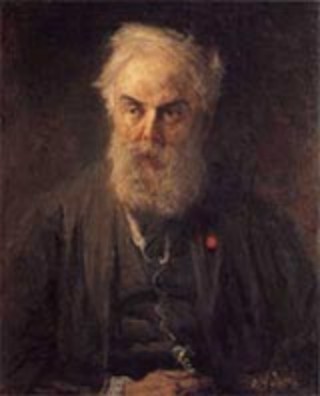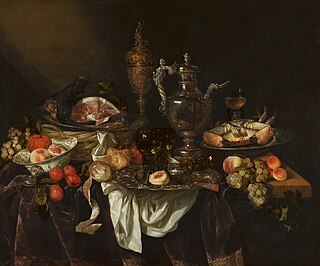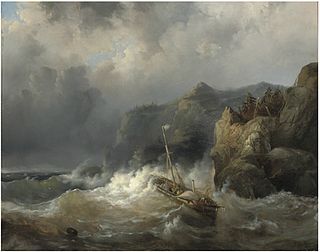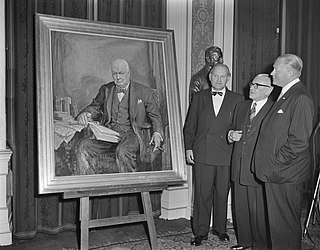
Carel Nicolaas Storm van 's Gravesande (21 January 1841, Breda - 7 February 1924, The Hague) was a Dutch painter, etcher and lithographer; associated with the Hague School. He is best known for seascapes, interior portraits and still lifes.

Carel Nicolaas Storm van 's Gravesande (21 January 1841, Breda - 7 February 1924, The Hague) was a Dutch painter, etcher and lithographer; associated with the Hague School. He is best known for seascapes, interior portraits and still lifes.
He came from an aristocratic family. Although he expressed an early interest in art, his father insisted that he study law. He did so, at the University of Leiden, and graduated in 1865. [1] Three years later, he defied his family's wishes and moved to Brussels, where he studied with Willem Roelofs, Paul Gabriël and Félicien Rops, [1] who taught him etching and became a lifelong friend.
In 1893, he returned to the Netherlands and settled in The Hague, where he became a member of the Hague School, a group of artists who had been heavily influenced by the Barbizon School. He continued to travel, however, with stays in Paris, Wiesbaden (for two years), [1] Cologne and Berlin. In 1900, he was awarded a gold medal at the Exposition Universelle. [2]
He is credited with helping to create a renewal of interest in etching as an independent art form and produced more than 400 etchings; mostly landscapes and cityscapes. [2] With Willem Witsen, he was a co-founder of the "Nederlandse Etsclub" (Dutch Etching Club). His works may be seen in museums around the world, including large institutions like the British Museum and the Detroit Institute of Arts and smaller museums such as the Owens Art Gallery in Sackville, New Brunswick. As a lithographer, he is believed to have been among the first to use aluminum plates, rather than stone or zinc. [2]

Lucas van Leyden, also named either Lucas Hugensz or Lucas Jacobsz, was a Dutch painter and printmaker in engraving and woodcut. Lucas van Leyden was among the first Dutch exponents of genre painting and was a very accomplished engraver.

Nicolaes Pieterszoon Berchem was a highly esteemed and prolific Dutch Golden Age painter of pastoral landscapes, populated with mythological or biblical figures, but also of a number of allegories and genre pieces.

Adriaen van de Velde, was a Dutch painter, draughtsman and print artist. His favorite subjects were landscapes with animals and genre scenes. He also painted beaches, dunes, forests, winter scenes, portraits in landscapes, as well as mythological and biblical scenes. He belongs to a group of painters referred to as the Dutch Italianate painters, who combined Dutch agricultural landscapes with mythological or Arcadian scenes in Italian settings. His paintings are characterised by their delicate, careful composition and his mastery of lighting effects as well as the human figure.

Simon de Vlieger was a Dutch painter, draughtsman and designer of tapestries, etchings, stained glass windows. While he is mainly known for his marine paintings he also painted beach scenes, landscapes and genre scenes.

Karel Dujardin was a Dutch Golden Age painter. Although he did a few portraits and a few history paintings of religious subjects, most of his work is small Italianate landscape scenes with animals and peasants, and other genre scenes. Dujardin spent two extended periods, at the beginning and end of his career, in Italy, and most of his paintings and landscape etchings have an Italian or Italianate setting.

Rembrandt Harmenszoon van Rijn, usually simply known as Rembrandt, was a Dutch Golden Age painter, printmaker, and draughtsman. An innovative and prolific master in three media, he is generally considered one of the greatest visual artists in the history of art. It is estimated Rembrandt produced a total of about three hundred paintings, three hundred etchings, and two thousand drawings.

Edmund Blampied was one of the most eminent artists to come from the Channel Islands, yet he received no formal training in art until he was 15 years old. He was noted mostly for his etchings and drypoints published at the height of the print boom in the 1920s during the etching revival, but was also a lithographer, caricaturist, cartoonist, book illustrator and artist in oils, watercolours, silhouettes and bronze.

Amsterdam Impressionism was an art movement in late 19th-century Holland. It is associated especially with George Hendrik Breitner and is also known as the School of Allebé.

The Rijksakademie van beeldende kunsten was founded in 1870 in Amsterdam. It is a classical academy, a place where philosophers, academics and artists meet to test and exchange ideas and knowledge. The school supports visual artists with a two-year curriculum.

Willem Roelofs was a Dutch painter, water-colourist, etcher, lithographer and draughtsman. Roelofs was one of the forerunners of the Dutch Revival art, after the Romantic Classicism of the beginning of the 19th century, which led to the formation of The Hague school. His landscapes, especially the early ones with their dominating cloudy skies, demure bodies of water and populated with cattle, are typical for the School of Barbizon.

Abraham Hendriksz van Beijeren or Abraham van Beyeren was a Dutch Baroque painter of still lifes. Little recognized in his day and initially active as a marine painter, he is now considered one of the most important painters of still lifes, and still lifes of fish and so-called 'pronkstillevens', i.e. sumptuous still lifes of luxurious objects.

Willem Kalf was one of the most prominent Dutch still-life painters of the 17th century, the Dutch Golden Age. We first get acquainted with Willem Kalf through Arnold Houbraken, in his Groot Schilderboek, who speaks very highly of him. In fact, Kalf was a highly regarded and celebrated artist during his own lifetime. This was due to his extensive art knowledge and what we gain from Houbraken, his affable personality. His claim to fame now rests mostly on his mature still lifes, pronkstilleven in Dutch, which feature the most exotic and luxurious objects. This can be seen in for example, Still life with nautilus beaker and porcelain lidded bowl from 1662, which became an iconic piece of western art.

Willem Arnoldus Witsen was a Dutch painter and photographer associated with the Amsterdam Impressionism movement.

Jan Verkolje or Johannes Verkolje was a Dutch painter, draughtsman and engraver. He is mainly known for his portraits and genre pieces of elegant couples in interiors and, to a lesser extent, for his religious and mythological compositions. He was a gifted mezzotint artist. Trained in Amsterdam, Verkolje spent his active professional career in Delft where he had access to powerful patrons.
Hermanus (Herman) Berserik was a Dutch painter and print maker. He was a member of the Pulchri Studio in The Hague. He studied art at that city's Royal Academy of Art, where his teachers included Willem Schrofer, Willem Jacob Rozendaal, and Rein Draijer.

The Tweede Schilderijenzaal, or Painting Gallery II, is one of two art gallery rooms in Teylers Museum. The Tweede Schilderijenzaal was built in 1893 as an extension of the first gallery.

Egide Linnig or Egidius Linnig was a Belgian painter, draughtsman and engraver who is best known for his marine art and occasional genre scenes. He was one of the first realist engravers in Belgium.

Simon Moulijn was a Dutch painter, draughtsman and graphic artist. He was one of the eminent visual artists of his time and became especially well known for his lithographic works.

Marten Ykes "Max" Nauta was a Dutch painter, especially noted for his portraits, and stained glass artist.

Passing Mother's Grave, also known as Passing the Churchyard, is an oil painting on canvas made in 1856 by Jozef Israëls, a Dutch realist artist and a representative of the Hague School of painters. The subject of the painting is a widowed fisherman walking past his deceased wife's grave with his two children.